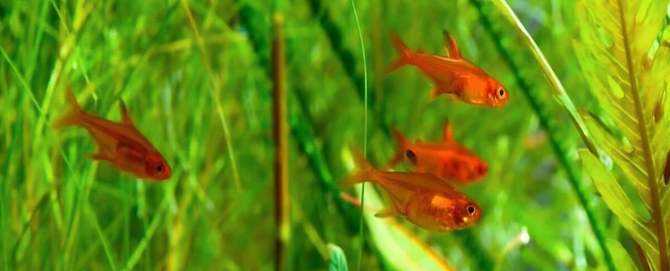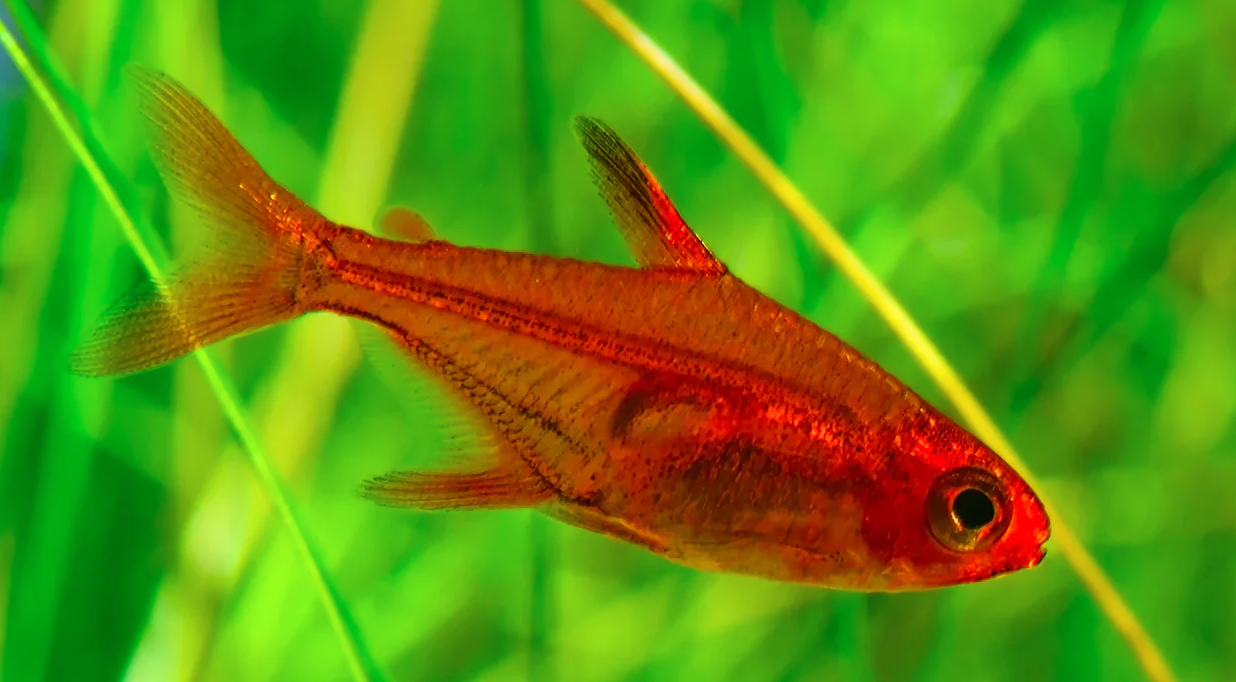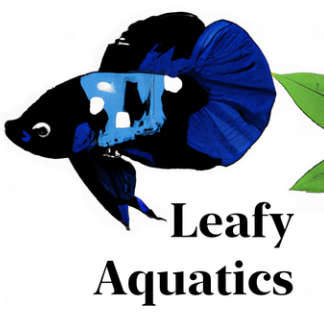Ember Tetra (Hyphessobrycon amandae)
Ember tetras are one of the most vibrant and popular freshwater fish in the aquarium hobby, renowned for their fiery orange-red coloration that resembles glowing embers–hence their name. Thousands of aquarists have been introduced to the hobby through caring for ember or other beginner tetras. Native to the clear, slow-moving waters of the Araguaia River basin in Brazil, these small characins bring a splash of tropical warmth to any community or planted aquarium. Ember tetra care is generally straightforward, making them a great beginner aquarium fish.
Scientifically known as Hyphessobrycon amandae, they were first described in 1915 and have since become a staple for beginners and enthusiasts alike due to their peaceful demeanor, hardiness, and ease of care. These schooling fish thrive in groups, displaying their best colors and behaviors when kept in numbers of at least six to eight individuals. Their slender, torpedo-shaped bodies and subtle black markings on the dorsal and anal fins add elegance without overwhelming the tank’s aesthetic.
Ember Tetra Species Overview
Adult Size: 0.8 inches
Lifespan: 2-3 years
Diet: Omnivore
Care Level: Easy
Minimum Tank Size: 10 gallons
Temperature: 72-82°F (22-28°C)
pH: 5.5-7.5
Origin: South America (Brazil)
Differences Between Ember Tetras and Other Common Tetras
Ember tetras (Hyphessobrycon amandae) stand out from other common tetras like neon tetras (Paracheirodon innesi), cardinal tetras (Paracheirodon axelrodi), and black neon tetras (Hyphessobrycon herbertaxelrodi) due to their compact size, vibrant coloration, and specific care needs. At just 0.8 inches, embers are smaller than neons and cardinals (both around 1.5 inches), making them ideal for nano tanks. Their fiery orange-red hue contrasts with the neon blue and red stripes of neons and cardinals or the black and green bands of black neons. Embers tolerate a broader pH range (5.5-7.5) than cardinals (4.0-6.0), but require softer water than black neons. While all are peaceful schooling fish, ember tetra care is less demanding in diet and tank setup, and they thrive in densely planted tanks without the cardinals’ need for pristine, acidic conditions.

Ember Tetra Care
Caring for ember tetras is straightforward, making them an excellent choice for those dipping their toes into the world of freshwater aquariums. These fish are adaptable but sensitive to sudden changes in their environment, so consistency is key. Start with a cycled tank to establish beneficial bacteria that handle waste, and perform regular maintenance to prevent ammonia spikes. Ember tetras prefer soft, slightly acidic water reminiscent of their Amazonian roots, but they tolerate a broader range than many tropical species. Monitor parameters weekly with a reliable test kit, and aim for low nitrates (under 20 ppm) to keep stress at bay.
Feeding
Ember tetras are not picky eaters, but a balanced diet is crucial for maintaining their signature glow and vitality. As omnivores, they relish a mix of high-quality flakes or micro-pellets as a staple, supplemented with occasional treats like brine shrimp, daphnia, or bloodworms to mimic their wild foraging. In the wild, they nibble on insects, algae, and plant matter, so offering vegetable-based foods like spirulina flakes or blanched spinach can enhance their health. Feed small amounts once a day, enough that they consume it within two minutes, to avoid overfeeding and water fouling. Juveniles may need more frequent meals to fuel growth, while adults do well on a once-daily schedule. Always remove uneaten food promptly, as these tiny fish produce minimal waste but can suffer if detritus accumulates. Pro tip: Use a turkey baster to target-feed bottom-dwellers if your tank has them, ensuring Embers get their share without competition.
Variety isn’t just the spice of life for humans, it’s essential for fish too. Studies from aquarium research groups, like those published by the American Cichlid Association, show that diverse diets reduce nutritional deficiencies in small characins. For the proper care of ember tetras, this means rotating proteins and veggies weekly. Avoid over-reliance on live foods to prevent introducing parasites, and opt for frozen or freeze-dried options from reputable brands. If your fish start fading in color or showing lethargy, it could signal dietary imbalance; up the protein content and observe.
Water Conditions
Water quality is the cornerstone of ember tetra care success. These fish hail from oxygen-rich, slow-flowing blackwater rivers stained by tannins from leaf litter, so replicate that with a pH of 5.5-7.5 and temperature steady at 72-82°F (22-28°C). Hardness should be soft to moderate (2-10 dGH), as higher levels can stress their gills. Use a heater with a thermostat to maintain stability, and consider an air stone or sponge filter for gentle circulation without strong currents that might exhaust these delicate swimmers.
Weekly water changes of 25-30% are non-negotiable, using dechlorinated water matched to tank parameters. Blackwater extracts or Indian almond leaves can naturally lower pH and add tannins, which not only acidify but also provide hiding spots and antifungal benefits. Test for ammonia, nitrite (always 0 ppm), and nitrate regularly; embers are particularly vulnerable to nitrite toxicity, which can cause gasping at the surface. If you’re in a hard-water area, a reverse osmosis unit or peat in your filter can soften it affordably. Remember, acclimation is vital–drip new fish into your tank over an hour to avoid shock.

Ember Tetra Breeding
Breeding ember tetras is a rewarding endeavor for intermediate aquarists, as they are prolific egg-scatterers that can produce hundreds of fry per spawn. Unlike mouthbrooders, they scatter adhesive eggs randomly, so success often requires separating parents from the clutch. To induce spawning, condition adults with high-protein foods like live brine shrimp for a week, then introduce a slight drop in temperature (to 70°F) and increase water flow. A tightly planted 10-20 gallon tank with fine-leaved plants like Java moss or spawning mops works best, as eggs adhere to these surfaces.
Spawning typically occurs in the early morning, with the male’s intensified colors and chasing behavior signaling readiness. Females swell with eggs beforehand, and once triggered, pairs release 100-300 transparent eggs over gravel or plants. Lighting plays a role–dim, indirect light mimics dawn in their habitat. After spawning, promptly remove adults, as they may snack on their own offspring. Water parameters during breeding: pH 5.0-6.5, temp 72-75°F. Patience is key; not every attempt succeeds, but with stable conditions you’ll likely see results.
Hatching and Fry Care
Once laid, ember tetra eggs hatch in 24-36 hours at 75°F, revealing tiny, transparent fry with yolk sacs for initial nourishment. By day three, they become free-swimming and voracious, demanding infusoria or liquid fry food for the first week–think green water cultures or commercial paramecium substitutes. Transition to baby brine shrimp or crushed flakes by week two, feeding multiple small meals to support rapid growth. Keep the tank dimly lit to reduce stress, and maintain pristine water with daily 10% changes using a turkey baster to avoid disturbing the fragile fry.
Raising fry to juveniles takes 4-6 weeks, during which mortality can be high (up to 50%) without vigilance. Overcrowding leads to stunted growth, so thin out if needed. Infusoria recipes are simple: boil lettuce in tank water and let it ferment under light. As they mature, their ember hues emerge around 4-6 weeks, a thrilling milestone. Provide gentle aeration and hiding spots like airline tubing wrapped in yarn. With diligence, a single spawn can yield dozens of healthy additions to your school.
Common Ember Tetra Diseases and Health Issues
While ember tetra care is generally straightforward, they aren’t invincible. Common culprits include ich (white spots), a parasitic protozoan causing lethargy and flashing; treat with raised temperature (to 86°F) and meds like Ich-X, but quarantine first. Fin rot, often bacterial from poor water, shows as frayed fins—improve hygiene and use antibiotics like Maracyn if advanced. Velvet disease, with gold dust on skin, demands copper-based treatments, but dose carefully as Embers are sensitive.
Stress from overcrowding or aggression (rare, but possible in small schools) weakens immunity, leading to fungal infections like cotton wool. Prevention trumps cure: Quarantine new fish for two weeks, maintain parameters, and watch for signs like clamped fins or rapid gill movement. Nutritional issues, like color loss from vitamin deficiency, resolve with better feeding. In community tanks, cross-species parasites from rasboras or danios can hitch a ride. Diversity is great, but vet compatibility and always quarantine new additions to a community tank for 1-2 weeks minimum. Early intervention keeps your flock thriving; consult a fish vet for stubborn cases.
Ember Tetra Tank Setup
Setting up an Ember Tetra tank is like crafting a slice of the Amazon: lush, serene, and functional. A 10-gallon minimum supports a school of six, but 20 gallons allows more flourish. Opt for a long, shallow tank to encourage swimming. Substrate: fine sand or smooth gravel in dark tones to make their orange pop; avoid sharp rocks that could injure barbels.
Plants are non-negotiable–Amazon swords, Vallisneria, or floating Anubias provide cover and simulate root tangles. Add driftwood or leaf litter for tannins and biofilm. Filtration: Sponge or hang-on-back with low flow; over-filtration stresses them. Lighting: Moderate LED (6-8 hours daily) to grow plants without algae blooms. Heater and thermometer essential. Decor like caves or silk plants adds security. Cycle the tank for four weeks pre-stocking. This setup not only houses but enriches their lives, reducing nipping and boosting displays.
Tankmates
Ember tetras’ peaceful nature makes them community stars, but choose tankmates wisely to avoid fin-nippers or bullies. Ideal companions: Other small tetras (neon, rummy-nose), rasboras (harlequin), or pygmy corydoras for bottom activity. Shrimp like cherry or Amano scavenge without threat, and snails (nerite) control algae. In larger tanks (30+ gallons), peaceful livebearers like guppies or endlers work, but monitor for overbreeding.
Avoid aggressive types: Bettas may see their fins as toys, and larger fish like congo tetras will outcompete for food. Schooling preference means solo embers get stressed, so keep always six-plus. Introduce fish simultaneously if possible to help establish hierarchy. A mixed school of tetras and corys creates dynamic, harmonious aquascapes, and would be my personal choice.
Ember Tetra Care Summary
In summary, ember tetras (Hyphessobrycon amandae) are the epitome of low-maintenance tropical flair: 0.8-inch adults live 2-3 years on an omnivorous diet in beginner-friendly 10-gallon tanks at 72-82°F and pH 5.5-7.5. Feed sparingly twice daily, change water weekly, and keep in planted setups for success. A lush, filtered tank with gentle tankmates like rasboras and corydoras ensures vibrant schooling behavior. These Brazilian gems reward simple dedication with endless ember-lit dances–perfect for any aquarist’s heart.

